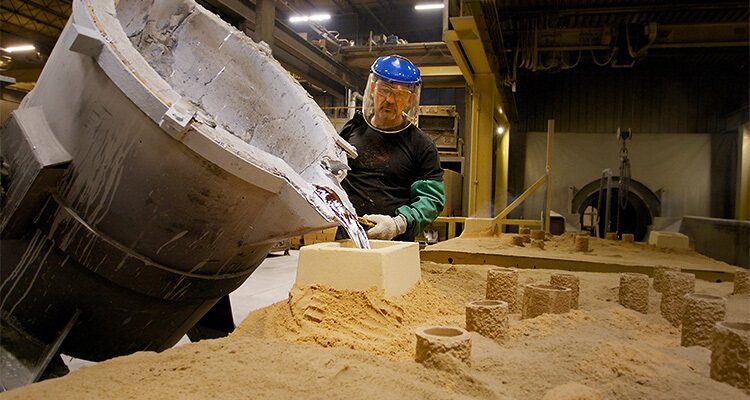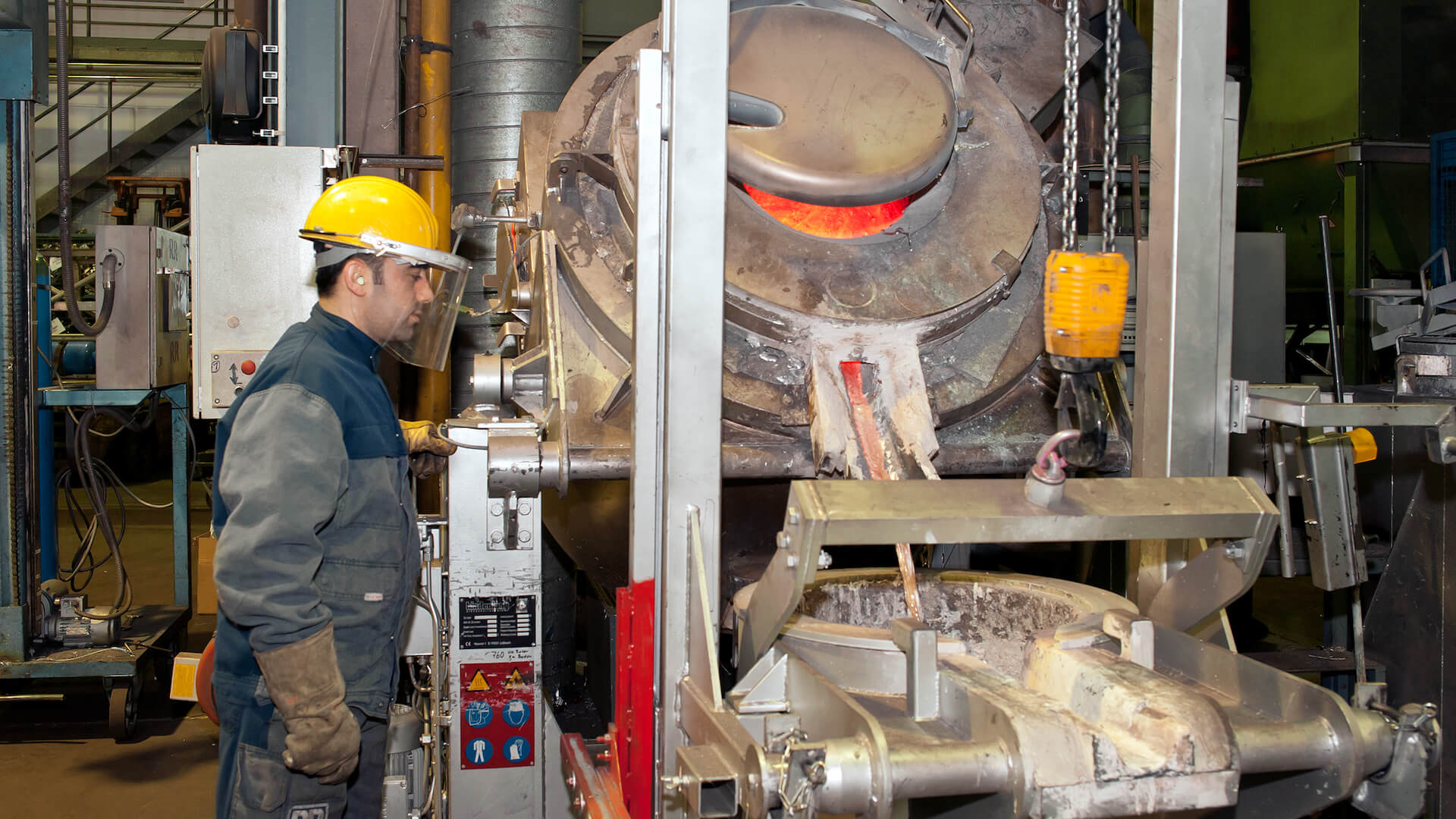Exploring the Cutting-edge Methods Made Use Of in Modern Aluminum Foundries
Modern aluminum foundries are going through a considerable improvement with the fostering of cutting-edge strategies. Advanced casting techniques, wise automation, and sustainable methods are reshaping manufacturing processes. These innovations not only improve effectiveness but additionally address ecological concerns. As the sector develops, the integration of electronic innovations plays an essential role. Recognizing these adjustments is important for grasping the future of aluminum manufacturing and its ramifications for international markets. What lies in advance in this vibrant industry?
Advanced Casting Techniques

In addition, innovations in thermal control and mold layout have added to more consistent casting outcomes. These developments enable much better control of cooling down rates, reducing problems and improving mechanical residential properties. Because of this, producers can create lightweight yet long lasting elements, satisfying the increasing demands of various sectors, consisting of automobile and aerospace, for high-performance aluminum components.
Smart Automation and Robotics
The assimilation of wise automation and robotics in aluminum foundries marks a substantial improvement in making effectiveness. These technologies enable precision and consistency in manufacturing processes, drastically lowering human error and boosting safety and security. Automated robotic systems take care of repetitive jobs, such as molding, pouring, and air conditioning, enabling human drivers to focus on more facility obligations that call for vital thinking and oversight.
Additionally, ai-driven analytics and wise sensors provide real-time information tracking, helping with anticipating upkeep and lessening downtime. This results in enhanced resource allowance and enhanced power intake, adding to overall sustainability in manufacturing.
Moreover, the versatility of robot systems permits for fast adjustments to altering manufacturing needs, boosting adaptability in manufacturing. As foundries progressively adopt these advanced technologies, they not only boost functional performance however likewise place themselves as leaders in advancement within the steel casting sector.
Additive Manufacturing in Foundries
Transforming conventional production approaches, additive production is reinventing aluminum foundries by making it possible for the production of complicated geometries that were formerly unattainable. This strategy enables the layer-by-layer construction of parts, substantially reducing material waste and reducing production times. Therefore, foundries can produce complex layouts that improve performance and capability, dealing with the expanding demands of different sectors.
Furthermore, additive production promotes quick prototyping, allowing designers to evaluate and iterate styles quickly. This agility not only increases the development cycle however also assists in identifying possible issues prior to full-blown production begins. The assimilation of advanced products and processes in additive production further improves the mechanical buildings of aluminum parts, advertising advancement in product style. Aluminum foundries that adopt these techniques place themselves at the leading edge of industry advancements, making sure competition in an ever-evolving market landscape.
Lasting Practices and Recycling
Lasting practices in aluminum foundries are increasingly concentrated on improving reusing procedures and adopting environment-friendly casting strategies. These innovations aim to lower waste and power usage while maximizing making use of recycled products. As the industry progresses, the integration of sustainability into manufacturing techniques comes to be crucial for satisfying ecological criteria and consumer demands.
Reusing Process Improvements
As markets significantly recognize the ecological effect of waste, aluminum foundries are embracing ingenious recycling process renovations to enhance sustainability. These innovations focus on lowering energy intake and maximizing product recuperation. Several foundries are implementing closed-loop systems that reuse scrap aluminum produced during manufacturing, minimizing waste and lowering the need for virgin products. Advanced sorting innovations, such as computerized optical sorting, boost the separation of various aluminum grades, raising the effectiveness of the reusing procedure. Furthermore, some foundries are making use of hydrometallurgical methods to recoup aluminum from complicated waste streams. By incorporating these renovations, aluminum foundries not only add to a round economy however additionally decrease their carbon impact, straightening with international sustainability objectives.
Eco-Friendly Casting Techniques
While typical casting techniques often include substantial power intake and product waste, aluminum foundries are increasingly adopting environment-friendly casting strategies that focus on sustainability. Strategies such as low-pressure die casting, which minimizes air discharges, and using water-based mold and mildew releases add to decreased ecological impact. In addition, innovations in 3D printing technology permit for the development of complicated molds with much less material waste. Many foundries are likewise carrying out closed-loop systems that recycle water and aluminum scrap, more decreasing source intake. By embracing sustainable power sources, such as solar and wind power, these centers enhance their sustainability initiatives. Generally, the adoption of green techniques in aluminum casting not only profits the environment but additionally promotes economic efficiency and development within the market.
Boosted Quality Assurance Measures
Enhanced high quality control measures in aluminum foundries are progressively dependent on sophisticated examination innovations and real-time tracking systems. These advancements allow manufacturers to spot issues early and guarantee regular item high quality. By incorporating these devices, foundries can markedly enhance their functional efficiency and decrease waste.
Advanced Evaluation Technologies
Advanced examination technologies play an important duty in making certain the top quality and integrity of aluminum spreadings. These sophisticated approaches consist of non-destructive screening (NDT) techniques such as ultrasonic testing, radiographic testing, and swirl present inspections. Each technique allows for comprehensive assessment of castings without jeopardizing their structural integrity. Advanced imaging strategies, such as computed tomography, supply a substantial sight of inner attributes, allowing the detection of problems like gaps and additions. In addition, automated optical inspection systems improve accuracy by employing high-resolution video cameras and artificial intelligence formulas to examine surface area top quality. By carrying out these sophisticated evaluation modern technologies, aluminum foundries can properly reduce defects, ensuring that spreadings satisfy rigid sector standards and customer needs.
Real-Time Monitoring Solutions
As makers undertaking for excellence in aluminum website casting, real-time monitoring systems become a critical improvement in quality assurance procedures. These systems make use of innovative sensing units and information analytics to constantly track essential criteria during the casting procedure, such as temperature, alloy, and pressure structure. By offering immediate comments, they make it possible for drivers to recognize variances from ideal problems and make punctual adjustments. This aggressive method not only lessens defects yet also improves overall effectiveness and minimizes waste - Metal Castings. Furthermore, assimilation of real-time information into manufacturing administration systems helps with much better decision-making and boosts traceability. Consequently, real-time tracking systems play a vital function in maintaining high criteria of top quality in modern-day aluminum foundries, making certain that products meet strict market requirements
Digital Double Innovation for Optimization

The integration of electronic twin modern technology enables foundries to check various circumstances without interfering with real manufacturing. This capability promotes an aggressive method to upkeep and source administration, inevitably minimizing waste and lowering operational expenses. In addition, the technology help in procedure optimization by enabling engineers to envision the results of changes in real-time, guaranteeing better results. As an outcome, aluminum foundries embracing electronic twin innovation are placed to accomplish greater efficiency and competition in a significantly requiring market.

Industry 4.0 and IoT Assimilation
The adoption of electronic twin innovation in aluminum foundries is part of a wider activity in the direction of Sector 4.0, identified by the integration of the Internet of Points (IoT) into manufacturing processes. This combination allows real-time monitoring and information collection from various machinery and equipment, leading to boosted operational efficiency. Sensing units embedded in makers collect crucial information, which is examined to enhance production process and anticipate maintenance needs.
In addition, IoT devices assist in interaction in between different manufacturing stages, permitting smooth coordination and lessening downtime. By leveraging cloud computer, foundries can keep and assess large amounts of information, allowing even more informed decision-making. This innovation also supports remote monitoring, where operators can supervise procedures from anywhere, enhancing responsiveness to manufacturing difficulties. Generally, the fusion of Market 4.0 and IoT within aluminum foundries is changing standard practices, making them a lot more agile and responsive to market needs.
Frequently Asked Concerns
What Are the Main Advantages of Aluminum Over Other Metals?
Aluminum uses various advantages over various other steels, including its lightweight nature, exceptional corrosion resistance, high thermal and electric conductivity, pliability, and recyclability, making it a preferred option for different applications across numerous industries. - Wisconsin Aluminum Foundry
Exactly How Do Modern Foundries Take Care Of Hazardous Materials?
Modern foundries manage hazardous materials through stringent security procedures, progressed filtration systems, and recycling techniques. Normal training warranties employees understand best methods, while monitoring systems spot and minimize potential risks to maintain a risk-free workplace.
What Is the Normal Lifespan of Aluminum Castings?
The normal lifespan of aluminum spreadings ranges from 20 to 50 years, depending upon factors such as environmental problems, usage, and maintenance. Appropriate care can prolong their sturdiness and efficiency considerably in time.
Exist Any Health And Wellness Threats Connected With Aluminum Foundry Work?
Yes, aluminum shop job positions health and wellness risks, consisting of breathing concerns from inhaling fumes and dust, skin irritability from call with molten steel, and prospective direct exposure to harmful chemicals. Appropriate precaution are important to minimize these dangers.
How Do Shops Make Certain Worker Safety And Security in High-Temperature Environments?
Shops implement rigorous security procedures, consisting of safety gear, temperature level monitoring systems, and routine training. These steps ensure that workers are furnished to handle high-temperature atmospheres, minimizing threats and promoting a much safer office.
Numerous sophisticated casting techniques have emerged in aluminum foundries, changing standard procedures. Lasting techniques in aluminum foundries are increasingly focused on enhancing recycling procedures and adopting eco-friendly casting methods. Numerous foundries are executing closed-loop systems that reuse scrap aluminum produced during production, reducing waste and minimizing the requirement for virgin products. While typical casting methods frequently involve substantial energy intake and product waste, aluminum foundries are increasingly taking on environmentally friendly casting methods that focus on sustainability. While lots of markets are significantly adopting digital modern technologies, aluminum foundries are leveraging digital twin innovation to improve operational effectiveness and maximize production procedures.